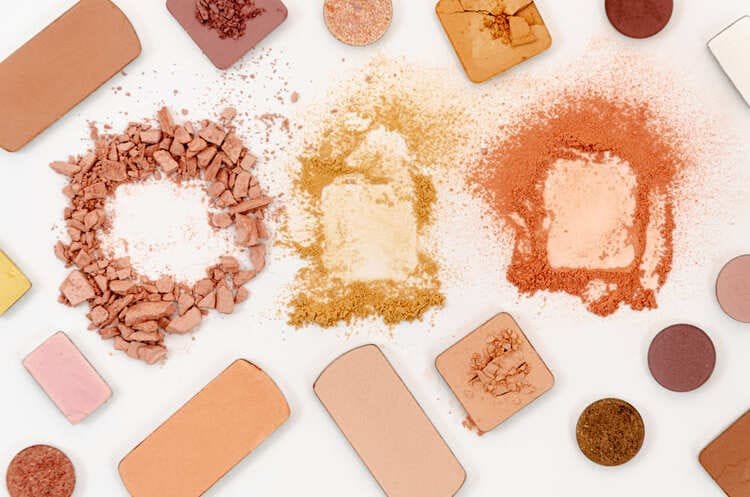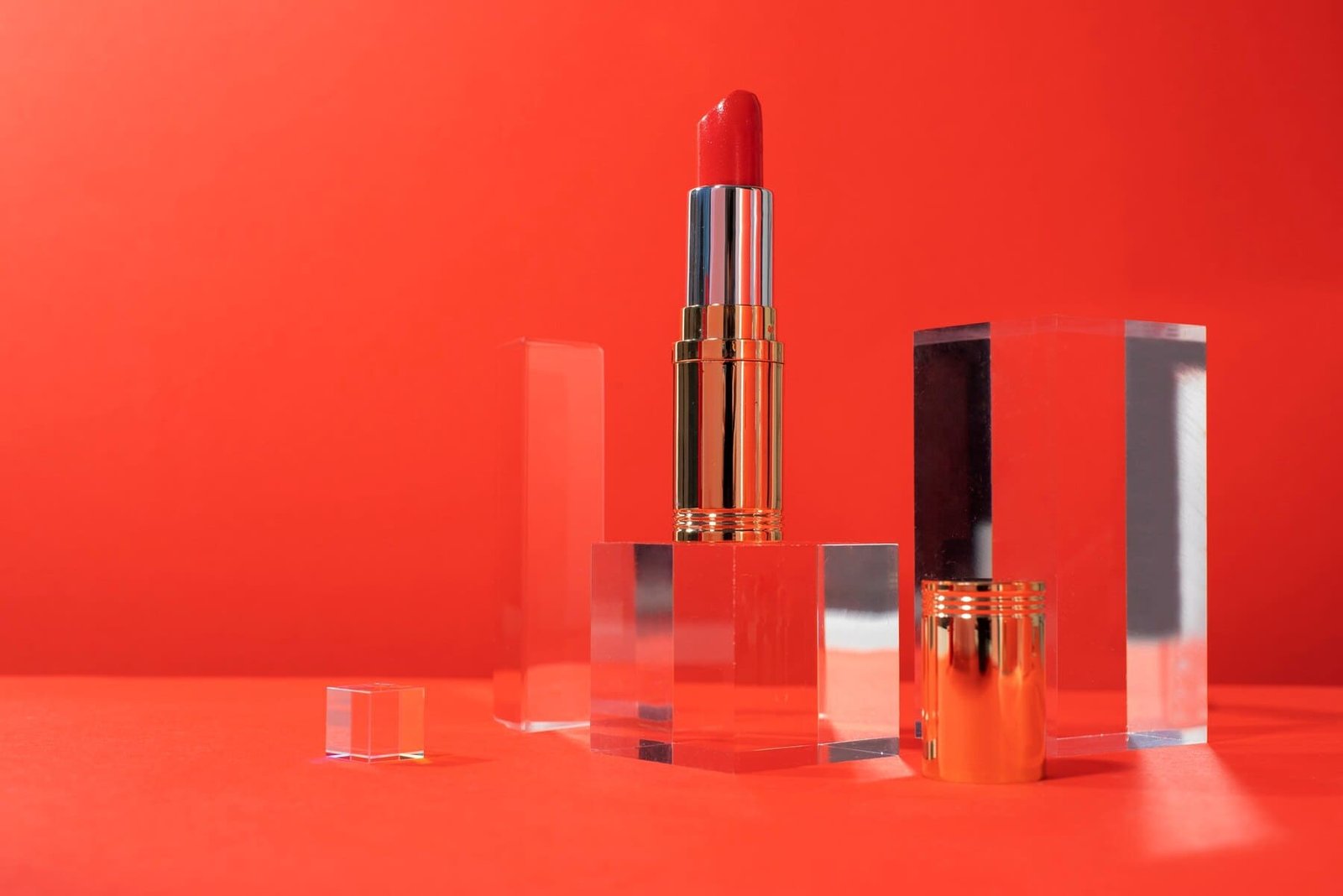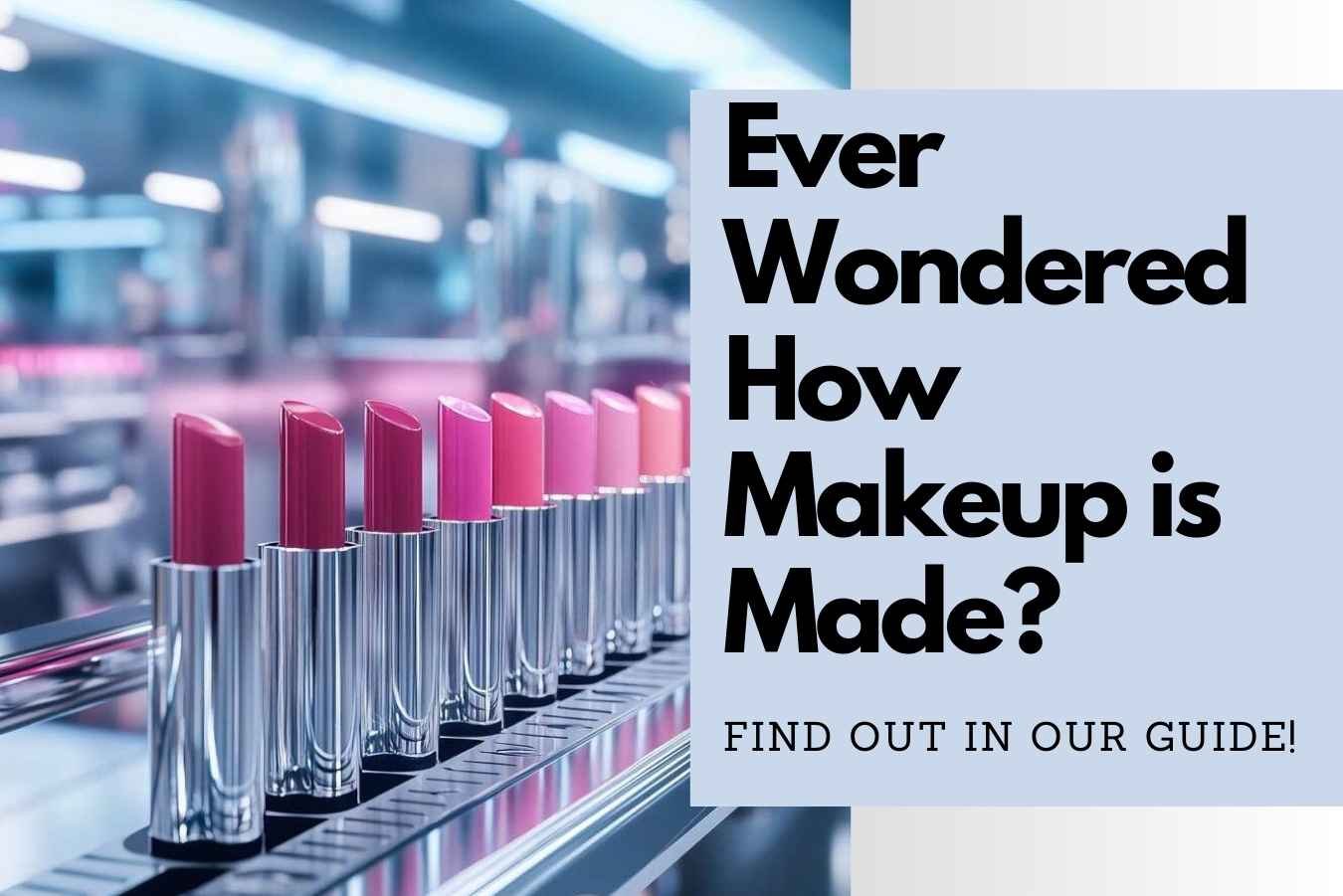Makeup Production has come a long way, from ancient Egypt where people used minerals and plant-based ingredients, to today’s advanced, high-tech formulas and cruelty-free products. But how is makeup made in modern times? Whether you’re applying bold lipstick, blending foundation for a flawless look, or dusting eyeshadow onto your eyelids, each product in your makeup bag undergoes a detailed process before it gets to you.
This article will take you through the step-by-step process of makeup production, explain the key ingredients used, and explore the science behind makeup formulations.
The Ingredients Used in Makeup Production

Makeup products are crafted from a combination of functional and aesthetic ingredients. Each ingredient plays a specific role, in ensuring the product is safe, effective, and visually appealing.
Pigments in Makeup Production
Pigments are essential for giving makeup its color. They can be natural or synthetic, depending on the product.
- Natural pigments are derived from minerals such as iron oxides, ultramarines, and titanium dioxide. These pigments provide earthy and subtle tones.
- Synthetic pigments are lab-made, like D&C Red 7, and are known for their bright, long-lasting colors.
For example, a rich red lipstick might use iron oxide for its warm, natural base tone. Titanium dioxide could be added to make the color more opaque. Finally, D&C Red 7 might be included to enhance vibrancy and create a striking red shade.
Emollients in Makeup Production
Emollients are essential ingredients that give makeup a silky, smooth texture. They help makeup glide effortlessly onto the skin, making application easy and even. Additionally, emollients lock in moisture, keeping the skin hydrated and comfortable throughout the day.
Emollients are carefully chosen based on their ability to nourish the skin and enhance product performance. Some of the most commonly used emollients include:
- Jojoba Oil: Lightweight and non-greasy, perfect for a natural, smooth finish.
- Shea Butter: Rich and creamy, ideal for deep hydration and softness.
- Squalane: A skin-friendly oil that provides a soft, silky feel without clogging pores.
- Coconut Oil: A natural moisturizer that ensures smooth application and a glowing finish.
In creamy foundations, emollients like jojoba oil are often used to create a smooth, even texture. These ingredients allow the foundation to blend easily onto the skin, leaving a flawless finish without feeling oily.
By including emollients, makeup products not only enhance application but also help improve skin hydration.
Binders in Makeup Production
Binders are crucial components in makeup formulations, ensuring products maintain their structure and stability. They help powders stay compact and prevent creams from separating, preserving the product’s integrity and performance over time.
Binders act as glue, holding ingredients together to ensure smooth application and durability. Without binders, powders could crumble, and creams might lose their texture, making them difficult to use.
Here are some widely used binders and their roles in cosmetics:
- Beeswax: Often used in lipsticks and eyeshadows, it provides structure and ensures smooth application.
- Silicones (like Dimethicone): Adds smoothness to makeup, improving its texture and blending capabilities.
- Gums (like Xanthan Gum): Creates thickness and viscosity, especially in liquid or gel-based products.
For example, in pressed eyeshadows, beeswax ensures the powder stays compact in the pan while still applying smoothly. Similarly, dimethicone in foundations enhances the silky finish and ensures even coverage.
Preservatives
Preservatives are vital in makeup production. They stop harmful microbes like bacteria, mold, and yeast from growing, ensuring the product stays safe for use.
Makeup products, especially those that are water-based, are prone to microbial contamination. Preservatives extend their shelf life, maintain product quality, and prevent potential skin problems caused by spoiled formulas.
Here are some popular preservatives and their benefits:
- Phenoxyethanol: A widely used, skin-friendly preservative that protects liquid and cream-based products from bacterial growth.
- Sodium Benzoate: Effective in preventing mold and bacteria, especially in water-based formulas.
- Potassium Sorbate: Commonly added to cosmetics to inhibit yeast and mold growth.
Without preservatives, products like liquid foundation could spoil in just weeks. This increases the risk of skin irritation, infections, and waste.
Fillers
Fillers are key ingredients in makeup formulations that add bulk, improve texture, and create the desired finish. They help products apply smoothly and feel comfortable on the skin.
Fillers influence how makeup looks and feels. They can control oil, add shine, or provide a silky finish, depending on the desired effect. They also help makeup products spread evenly and blend seamlessly.
Here are some common fillers used in cosmetics and their benefits:
- Talc: Creates a silky, smooth texture and is commonly used in powders like setting powder and blush.
- Mica: Adds a beautiful shimmer or subtle glow to products, such as eyeshadow and highlighter.
- Silica: Controls excess oil, making it ideal for products like mattifying powders or foundations.
Fillers not only improve how makeup feels and applies but also determine the overall finish. Whether you prefer a matte look or a glossy shine, fillers help achieve the perfect finish for your makeup.
Additives
Additives are special ingredients in makeup that offer extra skincare benefits. They can hydrate, protect, and soothe the skin while enhancing the makeup’s performance.
Additives like hydration boosters, antioxidants, and soothing agents ensure that makeup not only beautifies but also nurtures the skin.
Here are some popular additives and how they support skin health:
- Hyaluronic Acid: Known for its incredible ability to hydrate the skin, keeping it plump and fresh.
- Vitamin E: A powerful antioxidant that protects skin from environmental damage and supports skin health.
- Aloe Vera: Offers soothing properties, helping calm and hydrate the skin, especially in sensitive areas.
Extra Benefits: By including additives, makeup becomes more than just a beauty tool. These ingredients provide skincare benefits, helping to keep your skin healthy and radiant throughout the day.
Step-by-Step Process of Makeup Production

The manufacturing process transforms raw ingredients into polished makeup products. It begins with formulation, where cosmetic chemists select the right chemical compounds, emollients, and binders. Precise measurements ensure consistency in texture, color, and performance. Extensive testing is followed to meet industry standards and ensure the makeup performs as expected under various conditions.
- Formulation: Once the formula is ready, the next step is mixing. All the ingredients are blended in large industrial mixers to form a smooth, even texture. During this phase, products like foundation need to have pigments mixed evenly throughout the product to avoid any streaking or uneven coverage when applied to the skin.
Continuous stirring is crucial to ensuring the product maintains its consistency throughout the entire batch.
- Mixing: In some cases, manufacturers heat the product, especially for items like lipstick that contain waxes and oils. They melt these ingredients together into a liquid before adding pigments to achieve the desired color and texture. The melting process allows the ingredients to blend seamlessly, ensuring that the product is smooth and even once it cools.
- Heating (Optional): Next comes the molding and shaping stage. Once the product reaches the desired texture, manufacturers pour it into molds or shape it into its final form. They usually pour lipsticks into molds, where they are left to solidify into the familiar bullet shape that consumers recognize.
Manufacturers press powders into pans under controlled pressure, helping them take a compact, solid form. The pressure ensures that the product won’t crumble or break when consumers later use it.
This stage is all about giving the product its final shape, which is essential for its functionality and appearance.
- Molding and Shaping: In some cases, products such as lipsticks may undergo a cooling process to help solidify them further. Cooling allows the product to hold its shape and ensures that it remains firm and intact when removed from the mold.
This process makes the product durable and prevents it from softening or melting during transportation or while stored in warm environments. After the product has cooled and solidified, it is ready for the final stages of production.
- Cooling (Optional): Finally, manufacturers fill the makeup into containers, seal them, and label them in the packaging phase. They carefully fill liquid products, like foundations or lip glosses, into tubes or bottles, ensuring that the right amount is dispensed. They place solid products, such as compact powders or blushes, into sturdy cases or compacts to ensure they stay intact.
The manufacturers then seal the products to prevent contamination and label them with necessary information, including ingredients, brand name, and usage instructions. After completing the packaging, the manufacturers ship the products to retailers, making them available for consumers to purchase.”
- Filling and Packaging: The final step in the process is filling the products into their containers, sealing them, and adding labels. Manufacturers carefully fill liquid products, such as foundations or lip glosses, into tubes or bottles, ensuring that the right amount is dispensed and the packaging is secure. They place solid products, like powders, blushes, or eye shadows, into compacts or cases, making them easy for consumers to use and carry.
Once the manufacturers fill and securely seal the products, they label them with important information like the product name, ingredients, and usage instructions. After this, the products are ready for distribution to retailers and ultimately to customers.
Organic, Vegan, and Cruelty-Free Makeup
In today’s beauty world, many consumers are seeking products that align with ethical and sustainable values. Organic, vegan, and cruelty-free makeup options are becoming increasingly popular, offering alternatives to traditional products.
Organic makeup is made from ingredients grown without synthetic pesticides, fertilizers, or genetically modified organisms (GMOs). These products focus on natural ingredients that are healthier for both the skin and the environment.
Vegan makeup is free from animal-derived ingredients, such as beeswax, carmine, or lanolin. It ensures that no animals are harmed in the production of the product, making it a suitable option for those who follow a vegan lifestyle.
Cruelty-free makeup ensures that no animal testing is involved in the creation or development of the product. These brands take a stand against the practice of testing products on animals, offering ethical alternatives for conscious consumers.
Vegan-Friendly and Cruelty-Free Production
- Vegan Makeup: This makeup is entirely free from animal-derived ingredients, such as beeswax, lanolin, or carmine. Instead, it uses plant-based or synthetic alternatives, making it a great choice for those committed to a cruelty-free lifestyle.
- Cruelty-Free Beauty: These products are not tested on animals at any stage of development. They adhere to strict ethical standards, ensuring that no animals are harmed in the creation or testing of the products.
Sustainable Packaging Solutions
Beauty brands are shifting toward eco-friendly packaging options like:
- Recycled materials
- Biodegradable alternatives
- Refillable containers
Safety and Testing Standards in Makeup Production
Safety is a top priority in the beauty industry. Manufacturers must follow strict regulations to make sure their products are safe for consumers. The process includes thorough testing and approval to meet high safety standards.
- Lab Testing: Manufacturers perform stability tests to ensure that products stay effective and maintain their quality over time. These tests help verify that the product performs well even after long periods of use. Scientists conduct microbial testing to check for harmful bacteria, mold, or fungi. This ensures that the product is free from anything that could harm the skin, making it safe to use.
- Dermatologist-Approved Formulas: Many beauty products undergo clinical testing to ensure they are safe for sensitive skin. Dermatologists test and approve these formulas, confirming they are suitable for various skin types, including those that may be prone to irritation or allergies. When dermatologists approve a product, consumers can trust that experts have carefully tested it for both safety and effectiveness.
A Glimpse into Makeup Factories
Makeup production on a large scale involves advanced machinery and rigorous quality control. Factories follow precise protocols to ensure consistent quality, from raw material sourcing to final packaging.
Role of Technology in Modern Makeup Production
Innovation drives the cosmetics industry, with advanced technologies enabling:
- 3D printing for custom-designed products
- AI-based shade matching for personalized foundations
- Lab-grown pigments for eco-friendly alternatives
Facts about Makeup Ingredients in Makeup Production
Expert chemists create formulas by mixing pigments, oils, and other ingredients. The process involves careful blending, heating, and molding to make sure the makeup is high-quality and consistent.
Large machines blend the ingredients to ensure a smooth texture. Some products, like lipsticks or foundations, require heating to achieve the right consistency. Once the mixture is ready, the manufacturer pours it into molds for lipsticks or presses it into pans for powders. The manufacturer cools some products to solidify, while others remain in liquid form.
Many makeup brands follow cruelty-free practices, meaning they don’t test their products on animals. Some also use eco-friendly methods in their production process. From start to finish, the factory process ensures makeup is safe, effective, and ready for consumers.
Key Takeaways: The Art and Science of Makeup Production
Makeup production combines art, science, and innovation to create products that are not only beautiful but also safe and effective. From pigments to packaging, every step in the process contributes to the final product’s quality and appeal.
By understanding how makeup makers produce their products, consumers can make more informed decisions about the products they use and align their choices with their values and skin needs.”
How is Organic Makeup Made?
Organic makeup uses natural, plant-based ingredients free from synthetic chemicals. Popular organic ingredients include:
- Aloe Vera
- Coconut Oil
- Mineral Pigments
FAQs: What is Makeup Production: Complete Step-by-Step Guide
How is makeup made?
Makeup production involves a meticulous process that starts with selecting high-quality ingredients and blending them to create the desired formula. This process includes several key stages: formulation, mixing, optional heating, molding, optional cooling, and finally, filling, packaging, and labeling the products. Each step ensures the product is consistent, safe, and performs as intended.
What does cruelty-free makeup mean?
Cruelty-free makeup refers to products that are developed and tested without the use of animal testing. These products are created following strict ethical standards to ensure that no animals are harmed during their production, from formulation to testing, offering a compassionate alternative to conventional beauty products.
Why is testing important in makeup production?
Testing ensures that makeup products are safe, effective, and of high quality. This includes stability tests to assess the product’s shelf life, microbial testing to ensure the formula is free from harmful bacteria, and dermatologist approval to confirm that the product is suitable for sensitive skin types. These tests guarantee that the makeup is safe for consumers and performs well under different conditions
What role does technology play in makeup production?
Technology is driving innovations in makeup production, such as 3D printing for creating personalized beauty products, AI tools for accurate shade matching, and lab-grown pigments that provide eco-friendly color options. These technological advances not only enhance product customization but also contribute to sustainable and efficient production methods.

